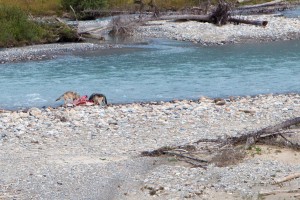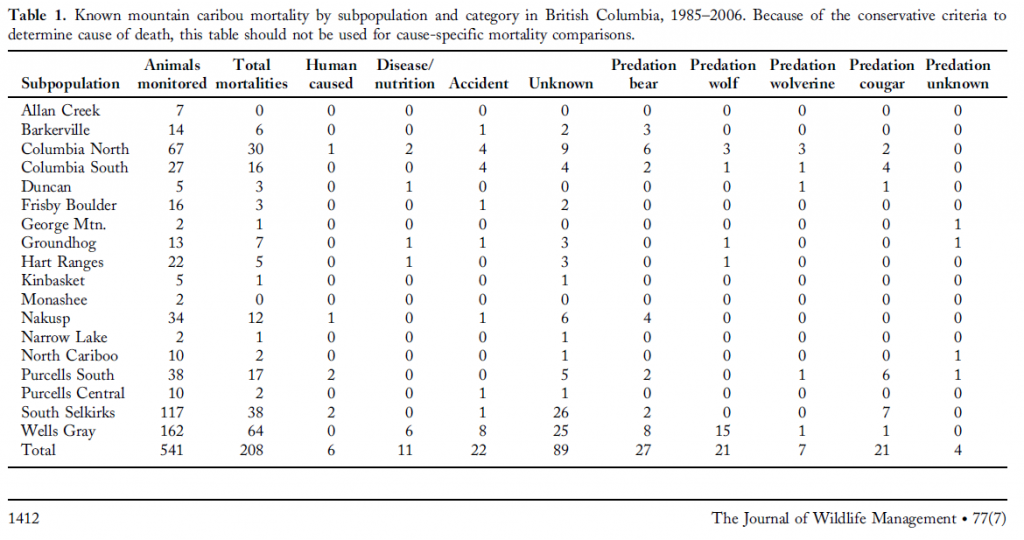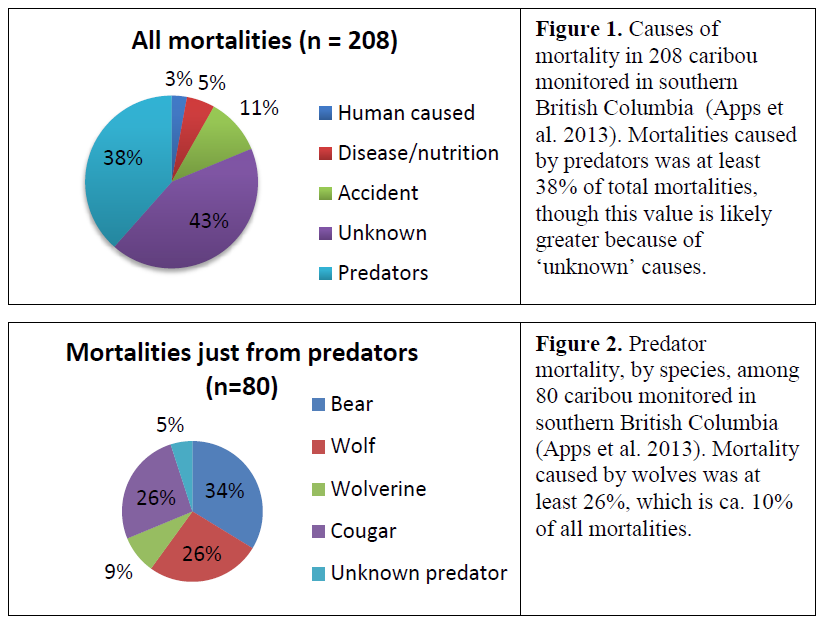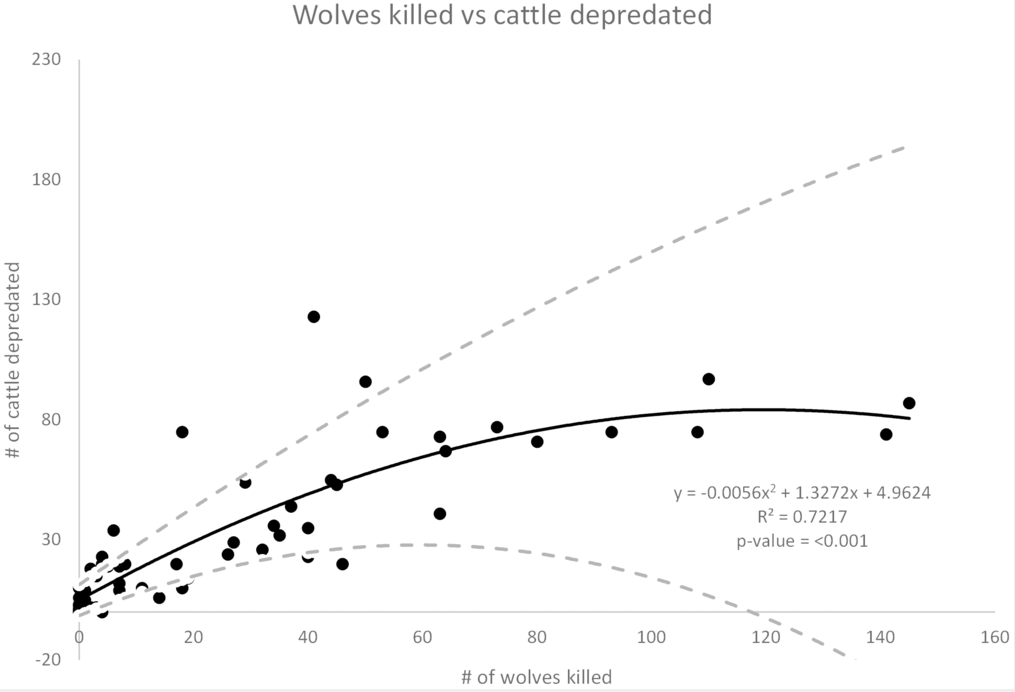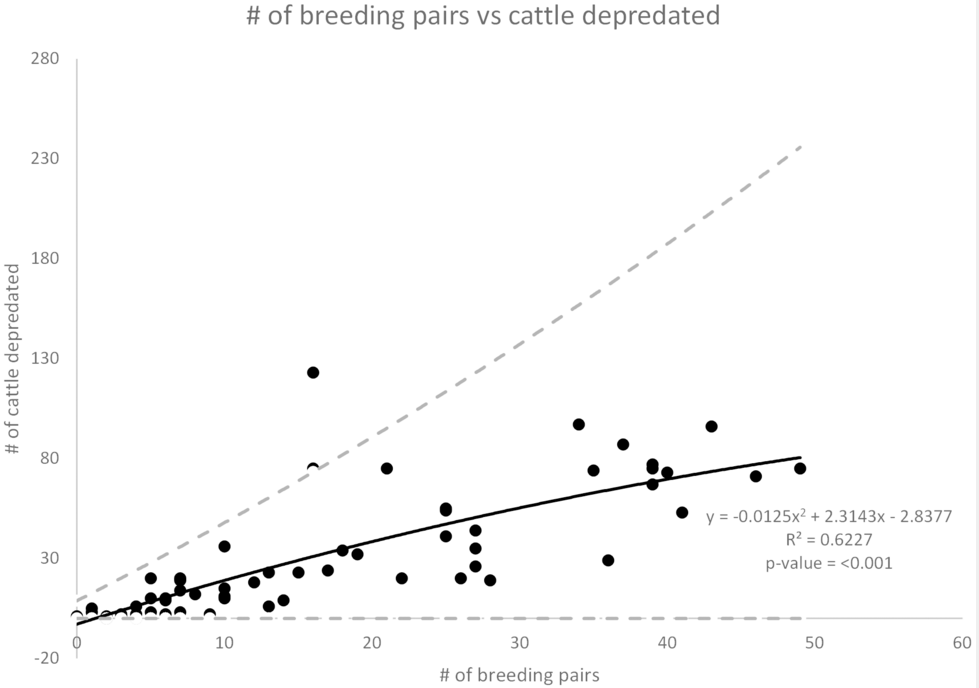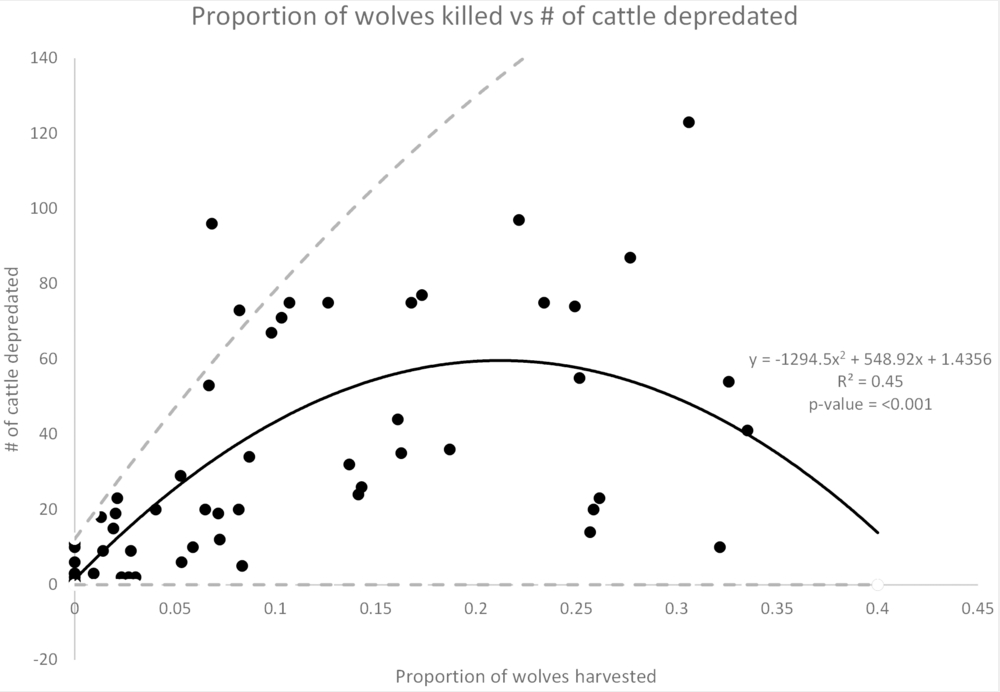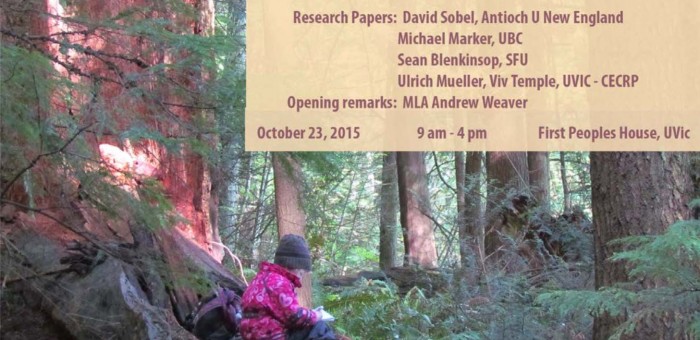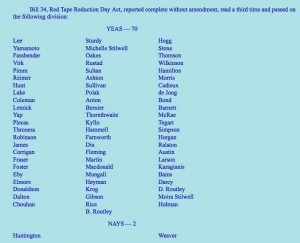Endangered Species Management: Caribou versus Wolves
Over the last few months British Columbia’s controversial wolf cull has been the subject of substantial public dialogue. Like most MLAs, I receive ongoing communication from numerous British Columbians questioning the rationale behind the government’s approach. These communications crescendoed when well known singer Miley Cyrus spoke out against the cull and urged her more than 23 million followers to sign a petition. One of the recent communications I received was from a young woman named Katie. She started off her email saying:
“My name is Katie, and I oppose the wolf cull. In school we learned about predator prey relationships. I know you probably won’t care, and that the government will go ahead with it anyway, but please read this…”
I found her email to be a source of inspiration. Despite her apparent cynicism towards politicians she took the trouble to express her concerns to me (even though she is not a constituent). Her email struck a chord. I campaigned on a promise of evidence-based decision-making and giving youth in our society, the generation that will have to live the consequences of the decisions my generation is making, a voice in the legislature. And so Claire Hume and I decided to look at BC’s controversial wolf cull a little more closely. What follows is an extensive analysis of the available literature. Our analysis derived from many hours of discussions with scientists, including wildlife biologists, with expertise in the area. I look forward to your comments.
 Is it justifiable to kill one animal in the name of saving another? What if one of those animals is endangered?
Is it justifiable to kill one animal in the name of saving another? What if one of those animals is endangered?
I have always maintained that humans have a moral obligation to prevent endangered species from going extinct, but wildlife management conflicts in which species are pitted against one another are always challenging. For a variety of industrial, social, or budgeting excuses, they are often situations that have been allowed to escalate far past a point of simpler intervention. When you start rationalizing culling one species to protect another you also introduce an ethical element that needs to be considered alongside scientific findings. Let one – or both – of those species become threatened or endangered and your situation becomes immensely worse.
Many ecosystems have been altered so drastically that we can no longer let nature take its course. If we don’t continue to intervene with the mountain caribou crisis we are currently facing in B.C., for example, it will not be long before the remaining herds in the South Selkirk and Peace regions are extirpated. Ideally, our wildlife management system would never let things get this bad. But it happens. And when it does we have no choice but to make tough decisions.
In January I wrote to the Minister of Forests, Lands, and Natural Resource Operations to ask a number of questions regarding the rationale for the wolf cull in the South Selkirk Mountains and the South Peace region. In response Minister Thompson sent me the supporting data that backed up their wolf cull. I read through it and agreed that with 18 caribou left we needed to take immediate and drastic action to ensure as many caribou as possible survived through another breeding season. Since then, the issue has continued to polarize our province with both sides of the debate claiming science. And in many ways, both sides are right. There is supporting evidence that suggests, for certain situations, that culling wolves is an appropriate wildlife management tool. There are also many other studies that conclude that it is an ineffective solution, one that could make the situation even worse while causing a great deal of animal suffering in the process.
So, where do we go from here? We do a literature review of the available relevant research and we have a conversation. We explore the feasibility of other options and try to find a solution that maximizes protection for threatened species while minimizing the harm done to all other animals. Over the last few months my office has been talking to scientists and analyzing data across disciplines, across species, and across the country (across continents in one case) to learn more about endangered species management.
Lessons from the Vancouver Island Marmot
In the late 1990s the Vancouver Island marmot population dropped to 70 members. While clear-cut logging in marmot territory was thought to be the initial and main reason their population numbers were plummeting, the landscape changes also led to increased predation. Between 1995 and 2005 predation by wolves, cougars, and eagles accounted for 80% of marmot mortality. Much like the caribou, habitat destruction was the main catalyst for their decline and wolves moved in to take advantage of the new open landscape. I reviewed the group’s marmot recovery plan and contacted them to ask why predator control has never been a part of their strategy.
Their Executive Director, Viki Jackson, said they tried everything they could think of on Mount Washington in place of culling predators: they collared cougars and brought dogs in to scare them away, had “shepherds” stay with the marmot colonies, put dirty human clothes around to deter predators, put up fences, and used bear bangers. Having people camp with the marmots 24/7 worked well, Jackson said, but the other attempts didn’t do much. At the same time, they started to have success with their captive breeding program. Without their active intervention the Vancouver Island marmot would have likely gone extinct years ago.
When it comes to endangered species management, Jackson said, there will never be consensus but you have to do everything in your power to protect key females when animal numbers drop to extreme lows. You need to get them over the extinction hump and stable enough that other conservation efforts have a chance to help.
While the specifics of this case do not exactly translate to the needs of larger, transient animals like caribou, I found their imaginative approach to crisis species management inspiring. Threatened species in our province are facing very modern difficulties as they try adapt to new stressors and habitats changed by development. Perhaps we should be trying to combat these challenges with equally modern and innovative solutions before defaulting to predator culling, a practice that only targets one aspect of highly complex situations. With this thought I contacted Dr. Adam Ford from the University of Guelph’s Department of Integrative Biology to talk about the use of technology in wildlife research and management.
GPS Management
Global Positioning Systems (GPS) placed on collars, Dr. Adam Ford explained, can be used to pinpoint, with high accuracy, the location of an animal at a given time. It is also possible to track animals and process data almost instantaneously. Knopff and his colleagues, for example, used GPS to track cougar predation to study predator/prey interactions with immediate data retrieval. “Real time monitoring has enormous potential in the fields of wildlife ecology and conservation, especially for at-risk wildlife,” their report states.
With these systems you can monitor the spatial relationship between an animal and a wide variety of geographical features. Data can be collected that orients an animal in relation to specific points (like feeding grounds), linear features (roads, fence lines, fishing nets, etc.) and spatially dynamic features (like a mobile herd of livestock). Given these tracking advancements, and the incredible success scientist and conservation officers have had using them in wildlife management settings, it is hard not to feel hopeful imagining the great potential for their use with woodland caribou in BC. I think it would be worth assessing, for example, the feasibility of attaching GPS’ to select members of threatened caribou herds and their neighbouring wolf packs, as suggested by Dr. Ford. You could outfit caribou and wolves with GPS collars, Dr. Ford explained, and program them with a GSM-linked messaging system that warns managers when wolves, say, are within 1 km of the caribou. The managers could then travel to the coordinates shown in the GSM message, and herd the wolves away with aversive conditioning. That way, intervention is case-specific and the helicopter time is used much more efficiently. They use this method in Kenya with elephants to keep them away from crop fields and refer to it as ‘geofencing‘.
I appreciate comparing elephants to caribou sounds dangerously like an apples-to-oranges tangent, but the success the Save the Elephants organization has had with GPS-based wildlife management is incredible and certainly worth further consideration. Their Geo-fencing program started ten years ago, in the hopes of reducing human-elephant conflicts. “Kimani was the first elephant to be collared and tested under the Geofencing [system]. He became the focus of the Ol Pejeta management due to his considerable skill in breaking expensive fences. In December 2005 he went on a crop-raiding spree that lasted 21 straight nights.”
In phase one of the project they programmed a virtual fence line (or string of coordinates) into the GPS collar worn by the elephant. If the elephant strays out of his designated range – suggesting he is heading towards farms or villages – his collar sends a text message with his exact location to the reserve managers, who can then mobilize and intervene with negative reinforcements before he does too much damage. After only a few months in his GPS collar, Kimani the elephant had stopped breaking fences. Years later, Kimani has still not returned to his crop-stomping ways.
Another breakthrough, which does not relate to caribou but highlights the brilliant potential for innovative wildlife management strategies, was their elephants and bees hypothesis. “Having found that elephants run from the sound of bees, in 2007, we set up a unique beehive fence line in the area to see if they would deter elephants from raiding crops. To test our hypotheses, we geo-fenced several known crop-raiding elephants to see if their behaviour changed once confronted with large concentration of bees. Thanks to the geo-fencing technology, we were able to witness and confirm that bees did in fact deter elephants from crop raiding.”
Elephant-caribou differences aside, the technology is transferable. “The real-time monitoring algorithms presented here for monitoring African elephants (proximity, geo-fencing, movement rate, and immobility) are widely adaptable and applicable to monitor a variety of behaviours across numerous species,” wrote Wall et al.
While there is considerable consensus within the scientific community about the effective use of technology in wildlife management, I have found concerning disagreement about the role of wolves in caribou declines and the impact of culling them. What follows is a literature review of sorts, of the relevant research that has been done on this subject.
Wolf Cull Literature Review
Apps et al. studied the GPS, very high frequency (VHF), and motion sensor data collected from 541 caribou over 22 years. When the collared animals stopped moving for prolonged periods researchers tracked their location and tried to determine the caribou’s cause of death. In their cause-specific mortality analysis of mountain caribou in B.C. they found that wolves are only one of many important sources of mortality for caribou. The data, though limited, indicates that wolves are not necessarily the primary killer of mountain caribou. In fact, it is possible that bears and cougars may have a stronger impact on caribou numbers. That said, I spoke to Dr. Clayton Apps about his study and he cautioned that the data should not generalized too broadly as it pertains to specific sampling cases. The wider conclusion of his work focused on caribou vulnerability as it relates to landscape changes. Wolf predation was found to be concentrated at lower elevations and areas with a higher concentration of roads, which they used as a navigational advantage when hunting.
On a similar theme, DeCesare’s data links industrial development with increased encounters between wolves and caribou, which in turn can lead to increased predation. Supporting that notion, other studies have illustrated the considerable impact wolves can have on local ungulate populations. Kortello et al. conducted a study that analyzed the diet and spatial overlap between wolves and cougars in Banff National Park. During their research they observed a 65% decline in local elk populations following the arrival of wolves. This shift caused cougars to switch from a primarily elk winter diet to one that favoured deer and other alternative prey options.
At this point we have a fairly clear picture of a wolf – caribou relationship that has been knocked out of whack in areas that have been altered by industrial development. Wolves eat caribou, even more so when roads and cleared forests give wolves efficient access to a larger range while simultaneously limiting caribou’s own food sources. If we have too few caribou, and too many wolves, it is easy to conclude a wolf cull would be an appropriate response. Some short term studies support that assumption. Bergerud et al. for example suggested that a wolf cull in Northern B.C. and the Yukon lead to increases in ungulate populations, but many studies do not.
In an incredibly comprehensive and long term study, Wielgus et al. assessed the effects of a wolf cull on reducing livestock depredations in Idaho, Montana and Wyoming from 1987–2012 using a 25 year time series. The number of livestock depredated, livestock populations, wolf population estimates, number of breeding pairs, and wolves killed were calculated for the wolf-occupied area of each state for each year. Unsurprisingly, their results describe a positive association between the number of cattle in a given area, the number of cattle killed, and the number of breeding wolf pairs. In other words, as you increase the number of cows and wolves in a given area, instances of wolf-cow conflict will also rise. Incredibly, however, their data also shows a positive, not negative, association with the number of wolves culled the previous year – meaning culling wolves actually led to more livestock being killed by wolves the following year. “The odds of livestock depredations increased 4% for sheep and 5-6% for cattle with increased wolf control” (graphed in Figure 1.). Wielgus et al., hypothesized that livestock depredation increased when wolves were killed because the cull disrupted pack structures, which in turn, lead to a compensatory increase in breeding pairs, more pups, and more hunting (Figure 2.). This trend was consistent until 25% of the breeding wolf pairs had been culled, after which point livestock predations began to decline from its elevated state (graphed in Figure 3.). As the paper stresses, however, “mortality rates exceeding 25% are unsustainable over the long term.” As you can see in Figure 3., to get to the livestock mortality rate that you started with before the wolf cull elevated depredation levels, you would need to kill over 40% of the breeding wolf pairs. Ultimately, Wielgus et al. concluded that their results do not support the ‘remedial control’ hypothesis of predator mortality which predicts a drop in livestock following increased lethal control. “However,” they write, “lethal control of wolves appears to be related to increased depredation in a larger area the following year.”
Figure 1: Wolves killed versus cattle depredated: The number of wolves culled the previous year plotted against the number of cattle killed by wolves the following year. The black line indicates that as more wolves were killed through control methods, the remaining wolves killed an increased number of cattle. The dashed lines show the upper and lower limits of the 95% confidence interval for the best fit line.
Figure 2: Number of breeding wolf pairs versus cattle depredated: The number of breeding wolf pairs present in a region the previous year plotted against the number of cattle killed by wolves the following year. The black line indicates that as the number of breeding wolf pairs increases, so to does the number of cattle they kill. The dashed lines show the upper and lower limits of the 95% confidence interval for the best fit line.
Figure 3: The proportions of wolves killed versus cattle depredated: The proportion of wolves killed the previous year versus the number of cattle killed by wolves the following year. The black line indicates a 2-way negative interaction. Cattle depredation increased with increasing mortality up until roughly 25% of the wolf population was culled, then the number of cattle killed began to decline.
Echoing their conclusion from a different research angle, Brainerd et al. analyzed pooled data from 148 territorial breeding wolves and found increased movement and dispersal of wolves when the pack’s breeding (alpha) pair was removed. In other words, when you kill the alpha wolf pair who keep the rest of the pack in line, remaining wolves are statistically likely to breed more and spread into new territories. This disruption to the ecosystem is likely to trigger other changes and lead to issues to neighbouring environments.
Similarly, Treves et al. found that the removal of carnivores generally only achieves a temporary reduction in livestock depredation before other predators move in to fill their space and eat their prey. Harper et al. also found that killing a large number of wolves in Minnesota did not reduce the following year’s livestock depredation levels. They did notice, however, that a mere increase in human activity decreased the amount of hunting wolves did in the area.
Caribou Health
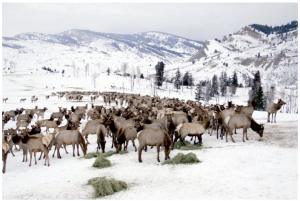
Credit: Mark Gocke, Wyoming Game and Fish
Unfortunately, there is yet another layer of concern to add to this complex analysis; caribou health. The University of Alberta’s Center for Conservation Biology began studying this issue after the government of Alberta announced plans to cull up to 80% of wolves in the oil sands in the hopes that it would slow the rate of caribou decline. They conducted dietary analyses had found that 60% of the caribou winter diet consisted of lichen. “This food source is particularly vital to pregnant caribou as it is high in glucose, which is the primary food source to the fetus,” they wrote. If female caribou do not have adequate access to lichen, they explained, it compromises their pregnancies and lowers birth rates.
“They [the government of Alberta] argue that climate change and habitat disturbance are causing deer, the preferred prey of wolves, to move north into the oil sands. Wolves are said to increase in response, increasing the risk of predation on caribou. Our work suggests that there may be better options.”
The conservation biologists suggested that reducing human and industrial activities in lichen rich feeding grounds may be a more effective mitigation strategy than killing wolves.
“Moreover,” they continued, “owing to the preference of wolves for deer, removing wolves from the population to protect caribou could actually place the ecosystem at markedly greater risk by accelerating the expansion of deer into this ecosystem.”
The Columbia Mountains Institute of Applied Ecology has picked up on this theme too. “Caribou decline may be related to too much energy spent on just trying to stay alive,” explained national park warden John Flaa. “Over the past summer, the three caribou mortalities I investigated had no body fat, which is bound to have an effect on calf production. Census results here show that the proportion of calves in the herd are below replacement level.”
Accessing an adequate food supply has been an ongoing issue for elk too, especially across the border in Wyoming. Their Game and Fish Wildlife Division, however, has managed to greatly inflate herd size over the last few decades by feeding them hay every winter. Not surprisingly, issues of disease began to increase as more elk congregated at feeding grounds. As Creech et al. explained; “High seroprevalance for Brucella abortus among elk on Wyoming feedgrounds suggests that supplemental feeding may influence parasite transmission and disease dynamics by altering the rate at which elk contact infectious materials in their environment.” Thankfully, they have also since shown that spreading out feeding areas reduces cross contamination infection rates by 70%.
This is not an ideal solution, of course, but it has been quite successful in many respects. Elk populations in Wyoming are now strong enough to support hunting, an activity that more than covers the cost of the feeding program. “Elk hunters spent $49.9 million in 2012… The program cost $558 per animal and generated $1,856 in ‘economic return’ per [elk].”
Conclusion
As Dr. Adam Ford wrote in his summary paper Science, Uncertainty, and Ethics in the Alberta Wolf Cull; “It is past time that we adopt a more creative view of how we can coexist with caribou and wolves in an industrialized landscape.” After reviewing the literature available on this and related issues I agree. While this is an undeniably complex situation with a lot at stake, I think we should be doing more to learn from innovative wildlife managers around the world.
We could try creating a geo-fence between wolves and threatened caribou like conservation officers do with their problem elephants in Kenya. Or get ‘caribou shepherds’ to track GPS collared herds, intervening when they are at risk of predation; much like the ‘marmot shepherds’ who saved endangered (admittedly easier to track) colonies on Vancouver Island. We could explore the feasibility of capturing, sterilizing, and re-releasing the alpha breeding pair in a pack of wolves; thereby reducing the growth of a wolf population while keeping the governing pack structure in place. Given the above concerns about food availability for caribou, as well as the effective use of feed lots elsewhere, I think we should also consider supplementing the diets of the South Selkirk and Peace region herds with a stable supply of lichen over the winter. It would be a relatively cost effective, simple, and could potentially be game-changing for our struggling caribou.
Some of these solutions may sound crazy, but when you consider we are currently spending millions of dollars to indiscriminately shoot wolves from helicopters, I would argue they potentially offer for more cheaper and less-crazy alternatives.
Acknowlegements
We are sincerely grateful to the many scientists who made time to talk to us about their work.
The Wonders of Nature Research Day
Today I was afforded the honour of delivering the opening the opening remarks at the Wonders of Nature Research Day put on by UVic’s Centre for Early Childhood Research and Policy. The research days featured presentations by a number of distinguished scholars including:
- David Sobel, Department of Education, Antioch University, New England
- Michael Marker, Department of Educational Studies, University of British Columbia
- Sean Blenkinsop, Faculty of Education, Simon Fraser University
- Ulrich Mueller, Department of Psychology, University of Victoria
- Viv Temple, School of Exercise Science, Physical and Health Education, University of Victoria
- Enid Elliott, School of Health and Human Services, University of Victoria
Below is the text of my opening remarks.
Text of Opening Remarks
 I would like to start off by thanking Beverley and everyone at the Centre for Early Childhood Research and Policy for inviting me here today and for organizing this wonderful conference. As Beverley pointed out, my name is Andrew Weaver and I’m the Member of the Legislative Assembly representing the riding of Oak Bay-Gordon Head — home to the University of Victoria.
I would like to start off by thanking Beverley and everyone at the Centre for Early Childhood Research and Policy for inviting me here today and for organizing this wonderful conference. As Beverley pointed out, my name is Andrew Weaver and I’m the Member of the Legislative Assembly representing the riding of Oak Bay-Gordon Head — home to the University of Victoria.
I have been in the Legislature for about two and a half years now, but before that I actually worked right here at UVic as a Faculty Member in the School of Earth and Ocean Sciences. In parallel with my endeavours in research, I’ve spent a good deal of time engaging the public in discussions about the importance of nature and our environment, and the detrimental path we are headed down if we don’t take action to reduce ongoing loading of the atmosphere with greenhouse gases that are causing global warming.
While it is easy to become disillusioned and worn out working in the field of climate science — seeing the path we’re headed down and fighting an uphill battle to try and make governments and policy makers see it too — it is our children and youth that inspire me — give me hope for the future — and keep me optimistic after so many years in this field.
In fact, one of my favourite parts about my role as MLA, is being able to go into schools and universities and speak to children and youth about our environment and the importance of civic engagement. Seeing their keen interest and appreciation for our natural environment and their desire to make our world a sustainable place is truly what inspires me in my daily work down in the legislature.
Because of this, I was very honoured when I was asked to provide opening remarks here today — I’m just disappointed I won’t be able to stick around to learn about the fantastic research that is being done in this area.
I was actually fortunate enough to experience a nature school program first-hand about a year and a half ago. I was invited by Savory Elementary School to be an “Eco Expert” for their “4 Seasons Eco School”. The program, which I believe was in its inaugural year when I visited, ran each Wednesday and provided all students with the opportunity to learn outside in Savory’s surrounding ecosystem, bringing in a new guest expert each week to guide the children.
I got to spend an entire day, from 8:30 in the morning to 2:30 in the afternoon, delivering a lesson plan to seven separate classes and engaging with every grade from Kindergarten to grade 6. To say that I was exhausted by the end of it would be an understatement, but it was also a truly unforgettable and inspiring experience — and helped to further my respect and appreciation for our teachers who do far more than I did, but on a daily basis.
Over the last decade as a scientist I’ve also had the privilege of working with school districts across Vancouver Island to install more than 150 weather stations on schools (Islandweather.ca for those who are interested), and to develop learning resources, in collaboration with teachers, to allow them to deliver their curriculum using state-of the art instrumentation and an authentic learning experience. Getting out of the ivory tower and into the community to discuss science, weather and our natural environment has been — to be perfectly frank — the single most satisfying and rewarding experience I have had as a scientist.
In today’s technology driven world, where young children are spending as much as eight hours a day interacting with screens — and often less than an hour a day actually outside – I firmly believe that providing children with the opportunity to experience “the wonders of nature” is one of the most important things we can do to help foster their development. While I am by no means an expert in the topic — you will hear from them later — I do know that there is a vast amount of research to demonstrate just how important time spent outdoors is to early development. Studies have shown that children who interact with nature on a daily basis are healthier, happier, more creative and less stressed than those who don’t.
And these benefits are not only felt in childhood. Researchers continue to develop a better understanding of the lasting impacts that early childhood experiences can have on our lives. Whether we remember the experience or not, and whether we are aware of magnitude of those experiences or not, they can stick with us throughout our entire lives. We carry them with us through our adolescent and teen years, into young adulthood and beyond. Developing an understanding and appreciation of nature at an early age will have a lasting effect on children.
And these benefits will not just be felt by the children fortunate enough to experience this type of learning environment. They will be felt by their peers, their families, their communities, and society as a whole. They will impact the way they interact with other people, the way that they view and interact with their environments — both built and natural, and the way that they engage in their future careers.
In a few decades, the children that we’re talking about today will be our teachers, our researchers, our scientists, our policy makers, and our government leaders. They will be making the decisions that influence our society, implementing the policies that protect our environment, and educating an entire future generation of children on the importance of our natural world. So the fact that you are all here today, discussing such an important initiative, is a truly inspiring sight to see!
Thank you again for having me here to speak today and enjoy the rest of the conference!
Culture of Cover-Up Must End Now
Media Statement October 22, 2015
Culture of Cover-up Must End Now: Andrew Weaver MLA
For Immediate Release
Victoria, B.C. – Andrew Weaver, Deputy Leader of the B.C. Green Party and MLA for Oak Bay Gordon Head welcomes the report today from Elizabeth Denham, Office of Information and Privacy Commission, and is calling on the government to immediately implement the report’s recommendations on documentation and retention of records.
“The government has repeatedly been criticized for either providing incomplete records, or claiming that no records exist, in response to Freedom of Information requests. They’ve further been criticized for ignoring previous recommendations concerning the creation and retention of records, use of personal email for government business, and oral communications where notes and documents should be required,” said Andrew Weaver, “There is a pervasive culture of cover-up that has become the status quo under this government. This has to end now.”
Further, Andrew Weaver is calling on the Premier to immediately implement the following recommendations from the OIPC:
- Technological changes to stop employees from permanently deleting emails;
- Mandatory training in records management, including training on what is a transitory record and what is not;
- Best practices to ensure that employees follow correct processes when responding to access to information requests and meet the duty to assist;
- Legislative changes including a duty to document key decisions of government, and oversight of information management and destruction of records with sanctions for non-compliance.
“The commissioner was clear when she stated that: ‘these practices threaten the integrity of access to information in British Columbia’ and I completely agree.” said Andrew Weaver, “The Premier ran on a promise of openness and transparency in government; evidently her definition of those terms is at odds with Elizabeth Denham’s as well as British Columbians’.”
-30-
Media Contact
Mat Wright
Press Secretary – Andrew Weaver MLA
Cell: 250 216 3382
Mat.wright@leg.bc.ca
Twitter: @MatVic
Parliament Buildings
Room 027C
Victoria BC V8V 1X4
BC Liberal LNG plans are a train wreck so let’s talk red tape reduction!
Today in the legislature we concluded the debate on the absurd Bill 34 – Red Tape Reduction Day Act. As I noted earlier, the sole purpose of the two-line Bill is to enshrine in law that in British Columbia, the first Wednesday in March would be declared Red Tape Reduction Day.
In British Columbia’s history there have been only five other Bills that legislated the dedication of a particular day. These are:
- British Columbia Day Act [1996]
- Douglas Day Act [1996]
- Holocaust Memorial Day Act [2000]
- Family Day Act [2012]
- Terry Fox Day Act [2014]
These dates correspond to either public holidays or profound events or individuals in our history. The normal process for government to recognize an event or occasion is through proclamation. In fact, there have been 148 such proclamations this year alone. Ironically, January 19-23 of this year was already proclaimed Red Tape Awareness Week. 2014 saw 165 such proclamations made by the Ministry of Justice.
Not only is Bill 34 a ridiculous waste of civil servant time and taxpayer money, but it also devalues the importance of other days that have previously legislated designations.
It has become apparent that the government now recognizes that its outrageous promises regarding a hypothetical LNG industry will not materialize. As I’ve been pointing out now for more than two years on this site and almost three years elsewhere, LNG was never going to be an economic reality in British Columbia any time soon. The BC Liberals misled British Columbians in the lead up to the last election campaign with outlandish and totally unrealistic promises. They threw a Hail Mary pass of hope, spinning in hyperbole, in a desperate attempt to win an election that no one thought they could win. Well that pass was caught, and they subsequently struggled to deliver the impossible.
The BC Liberals were given a mandate to deliver on a promise. They didn’t and they won’t. While the government will attempt to deflect blame on market prices, external pressures, third parties and so forth, the reality is that even despite their generational sell out exemplified in the Liquefied Natural Gas Income Tax Act, ironically supported by the official opposition, the government has failed to deliver as I pointed out it would because it couldn’t. And at the same time as I pointed out the folly of them chasing a pot of gold at the end of the LNG rainbow, I offered the BC Liberals an alternate vision of hope for the future — a vision of a diversified, sustainable, 21st century economy.
As we start to get closer to the 2017 election, the BC Liberals will attempt to rebrand themselves as the party of small business in an attempt to divert attention away from their colossal LNG failure. But it’s too late.
Below I reproduce the video and text of my brief closing remarks on this bill. The speech is only 1 minute 39 seconds long and I would recommend watching it if it’s the only thing you watch/read further. The Honourable Coralee Oakes, Minister of Small Business and Red Tape Reduction, did not stand to respond to the question that I posed at the end. Adrian Dix (NDP MLA for Vancouver-Kingsway) and George Heyman (NDP MLA for Vancouver-Fairview) subsequently rose to press her further on this, yet satisfactory answers were never received.
I also reproduce a longer debate that I had with the Minister. I was appalled at the Minister’s justification and rationale for introducing the Red Tape Reduction Day Act. In this extended discussion you will see that I proposed two amendments. The first was to move the date to April 1st; the second was to tie it to the fixed election date since as I noted, in my view, the most efficient way of reducing red tape would be to vote out the government that brought in all the red tape in the first place.
Every NDP MLA who spoke at committee stage did so passionately, articulately, and forcefully against Bill 34. They argued vehemently that the Bill devalued the importance of the other five legislated days mentioned above. Yet in the end, only Vicki Huntington (Independent MLA for Delta South) and I voted against the Bill at third reading (see below). This demonstrates yet another of example of the BC NDP saying one thing then voting against everything they believe in. I simply cannot understand how you could argue against a Bill then vote for it. Their approach was unprincipled and defies logic.
The Vote
Summary Video
Summary Text
A. Weaver: I do have a final question on section 1. But before I start, I would like to address that comment, because it is relevant.
Frankly, this government does not have a vision. The vision they sold British Columbians on was one of wealth and prosperity for one and all from a vibrant LNG industry, this pot of gold at the end of the rainbow that they are continually chasing. The reality is this misled British Columbians because it was never in the cards because the economic reality was LNG was not coming to British Columbia soon or anytime soon.
So in a desperate attempt to divert British Columbians’ attention away from their disastrous policies — yes, disastrous policies — on LNG, they bring us red-tape-reduction day. And in doing so, they’re trying to repurpose their campaign for 2017 to try to rebrand themselves as the party of small business. But they are not the party of small business. A party of small business would not throw small business under the bus and, in a desperate attempt to try to bring LNG here, send a signal to the clean-tech sector that they’re not welcome in B.C. — desperately trying to bring them back.
This is a cynical bill. It is a bill that will do nothing for the betterment of British Columbia. My question to the minister is this. It’s a question that is also in the mind of the member for Delta South. How much money is the government going to waste, of the B.C. taxpayers, to promote this bill, to create staff to administer it, to actually promote this day across schools? How much money and how much red tape is being introduced in B.C. through the passage of this bill?
Committee Stage Debate Text
A. Weaver: I have a number of questions. The first couple will build upon some of the earlier questions, and I want to follow up with that.
The minister, in response to the member for Delta South, suggested that in the first reading of the bill, the issue and notion of consultation were raised. I’d like to correct the public record on that and ask the minister further on that. In the first reading, which I have before me, it says:
“I am pleased to introduce Bill 34, the Red Tape Reduction Day Act for 2015. Bill 34 introduces a commitment by our government to host an honorary day devoted to reducing red tape through regulatory reform and the repeal of outdated or unnecessary regulatory requirements on the first Wednesday of March of each year. This legislation institutionalizes accountability and transparency of regulatory reform. It demonstrates our government’s commitment to ongoing…commitment to reduce the red-tape burden imposed on citizens and small businesses.
“Since 2001, we have reduced regulatory requirements by over 43 percent. Bill 34 will impose on government a requirement to reduce red tape and demonstrate its continued commitment to regulatory reform on the first Wednesday in March of each year. Reducing the regulatory burden on citizens and small businesses is critical to ensuring British Columbia’s economic competitiveness and providing all citizens with easy access to government services and programs.”
There is no mention of any consultation in first reading.
May I ask the minister if she will correct the record — agree with this for the Hansard record?
Hon. C. Oakes: Thank you. I actually meant second reading. My apologies.
A. Weaver: Another thing the minister said, which I think is very telling. As a direct quote, the minister — in response to, I believe, the member for Vancouver-Kingsway — said this:
“This act, this Red Tape Reduction Act, is a significant piece in ensuring that we are citizen-centred, that we’re providing an environment that improves efficiencies and processes, and it ensures that by making it an act that the reduction of red tape and our commitment to net zero, commitment to 2019, is maintained.“
Now, there are two questions that come from that. The first question is…. The minister refers to “Red Tape Reduction Act.” As far as I can tell, there is no red-tape-reduction act before us. My first question to the minister is: are we to expect a red-tape-reduction act in light of her comment earlier in the discussion today?
Hon. C. Oakes: I dropped the word “day,” obviously, in that statement. Thank you for allowing me to correct that in Hansard.
A. Weaver: My second question on this statement, then, is: what does the minister mean when she refers to “our commitment to net zero”? Is this a commitment to: if you add a regulation, you must remove a regulation? Could the minister please expand upon this?
Hon. C. Oakes: We made that commitment publicly, on a net zero to 2019. We report out on that in our annual report Achieving a Modern Regulatory Environment, which we put out each year.
A. Weaver: If ever there was proof that there’s nothing liberal about the B.C. Liberals…. I would refer members to the Statutes of Canada, chapter 12, assented to on the 23rd of April, 2015, wherein the Harper Tory government introduced a bill. This bill was entitled as follows: the Red Tape Reduction Act.
Now, the federal government made a big deal of this Red Tape Reduction Act, wherein it legislated, as a matter of law, that the requirement to add one regulation must be met with removing one of similar magnitude. That didn’t serve them very well, did it?
It’s a glorious day to be talking about the red-tape-reduction day here in the Legislature. We saw what happened when the public turned against a government that became cynical towards the people it represents. Here we have the same thing manifesting itself right before us: this government proposing Red Tape Reduction Day Act.
My question, then. Who in the general public has the ministry actually consulted, with respect to people — not organizations, the one organization that was quoted — individual people? I have heard, literally, from scores of constituents who are absolutely offended by the introduction of this bill. Who has the government consulted in preparation of the bill before us?
Hon. C. Oakes: The member opposite had a few questions in that. I will start. He asked the question of who we’ve heard from. Survey after survey of small businesses continue to say that red tape is top concern and express frustrations that governments are not taking the problem seriously enough.
To the second part. This government is committed to ensuring that we have citizen engagement. That is why, if you look at the citizen engagement process that led up to the liquor changes, the liquor reform included more than 40 meetings and 2,000 stakeholder e-mails. There was a significant level, by our government, to ensure that we had citizen engagement.
We had citizen engagement on the distracted driving, engagement with citizens of British Columbia. We engaged with citizens on the ten-year transportation plan — the ten-year British Columbia on the Move.
In the same respect, red-tape reduction for real people will ensure that we are doing citizen engagement across the province of British Columbia, with the commitment to ensure that we maintain focus on what we have heard is significantly important for British Columbians.
Further, we have, as we’ve mentioned earlier, a process in place where we will be capturing a number of questions from citizens throughout British Columbia. We’ll have a formal process to put that information out to the public so that members on both sides of the House can read what citizens are saying throughout British Columbia. Then there will be the opportunity, through the Red Tape Reduction Day Act, to ensure that government is accountable.
A. Weaver: I take that answer as nobody is being consulted. Clearly, we’re not talking about liquor regulations here. We’re talking about the Red Tape Reduction Day Act. We’re not talking about distracted driving. We’re talking about the Red Tape Reduction Day Act.
We’re not talking about these other acts that the minister referred to, and we’re not talking about reducing red tape. Every single person on this side of the House, the independents and the official opposition, would agree that red tape that exists for the sake of existing should be reduced.
However, we’re discussing why this act came to be. The only answer, for the record, based on this response and previous responses, is that not a single individual person in British Columbia was consulted. It was dreamed up as gimmick, a cynical gimmick, in back rooms.
Now I’ll come back to another specific question. The member for Surrey-Whalley introduced a private member’s bill called the Ukrainian Famine and Genocide (“Holodomor”) Memorial Day Act. Now, that bill was personal to me, because as I spoke, when Holodomor was recognized in this Legislature, I discussed my family’s history, my family who grew up and lived through Stalin’s collectivization of farms. Yet this act was not even brought through first reading to second reading to discuss.
We are debating the Red Tape Reduction Day Act, and we are not even willing, in this Legislature, to debate the Ukrainian Famine and Genocide (“Holodomor”) Memorial Day Act. What message is this government sending to the Ukrainian community in British Columbia? Let me tell you what message this is. This is a message that you don’t matter, but red-tape reduction matters.
My question to the minister is: will she encourage her cabinet colleagues to bring the Ukrainian Famine and Genocide Act forward subsequent to this bill?
Hon. C. Oakes: The member opposite knows that that is just untrue. The member opposite knows that it’s not an either-or. This is a piece of legislation that we are bringing forward to ensure that we have a focus, a focus on ensuring that we are reducing unnecessary burdens and red tape.
The member is also untrue when the member said that we did not talk to people. I would like to know if the member opposite thinks that small businesses aren’t people. The last I looked, small business owners have a right to communicate with government. Small business owners are individuals that are important.
We heard from the B.C. Chamber of Commerce. We heard from the Canadian Federation of Independent Business. We heard from the Coalition of B.C. Businesses that this was important. We heard from small business owners on the front lines of dealing with everything from dumb rules to lacklustre government service.
The simple fact that the provincial government is open to hearing some of these issues firsthand through their new public engagement strategy on red tape is a great way to kick off Small Business Month.
Members on both sides of the House were at our rotunda to celebrate the importance of small businesses in British Columbia. I expect that members on both sides of the House…. We have heard them say before that small businesses are, in fact, important in British Columbia. They have said that reducing red tape was critically important to ensuring that they are successful.
We are listening. We are going to continue the important consultation that we have committed to, not just for small businesses. We are going to commit to ensuring that this engagement process is cross ministries. We are ensuring that in every single minister’s mandate letter, there is a responsibility to take action on what we have heard from citizens throughout British Columbia, and we’ll be showcasing that on red-tape-reduction day, the first Wednesday of March.
A. Weaver: Wow. It may come as a surprise to realize that I didn’t think that businesses were people. In fact, businesses are businesses, and people are people. Businesses don’t vote; people vote. People are the ones who elect governments — not businesses, not unions. So clearly, no people were contacted with respect to this bill.
Coming back to the question of small business, this side of the House is very supportive of small business. But the actions matter. Gimmicks don’t. Red-tape-reduction day is not helping small business. As the member for Burnaby–Deer Lake pointed out, it’s actually creating red tape, ironically. The fact that we’re debating this, ironically, is creating more red tape.
As a final thing on this topic, I’d like to correct the record again. The evidence is very clear. The minister said that it’s not either-or. The evidence is clear. The member for Surrey-Whalley put forward a private member’s bill, which is on our order papers. That private member’s bill was the Ukrainian Famine and Genocide (“Holodomor”) Memorial Day Act. That bill was never brought to this Legislature for discussion. That is a fact. Anybody can go to Hansard to check it.
The Red Tape Reduction Day Act — we’re discussing it now at committee stage. The facts are clear. This government cares more about its cynical, small business apparent…. It’s actually not. It’s increasing red tape. It’s caring more about a gimmick — it’s not about reducing red tape — than the actual issues out there that matter to British Columbians.
My question to the minister again is this: have you discussed with the Ukrainian community of British Columbia with respect to whether or not they support your act here to create red-tape-reduction day and not even bring for discussion the Holodomor act that the member for Surrey-Whalley brought forward?
Hon. C. Oakes: Again, the member opposite knows full well it’s not an either-or, that this is about introducing a focal point of our government that we’ve heard from citizens across British Columbia is important. It makes sense to have a specific day for the people of British Columbia to reflect on progress being made by their government on clearing out unnecessary rules, sweeping away old and cumbersome regulations and ensuring that red tape doesn’t clutter the environment for small business.
Small businesses — survey after survey after survey — have identified that red tape is a concern and a frustration to them if governments do not take it seriously. Complying with rules and regulations — and the member opposite talked about the federal approach to red-tape reduction — cost Canadian businesses of all sizes $37 billion in 2014, including $5.2 billion in British Columbia. Small business owners believe that the regulatory burden could be reduced by about 30 percent, for an annual savings to the economy of $11 billion.
I would suggest to British Columbians that reducing unnecessary red tape and burdens and ensuring that we are creating a competitive environment for small businesses is important to British Columbians, while enhancing the process that we are doing to engage with British Columbians across ministries to ensure that the success we’ve had with small businesses — that support — can be engaged through citizen engagement, through ministries across government.
A. Weaver: Well, of course. We all agree with that. But this bill is not reducing red tape. We’re not discussing reducing red tape. We’re discussing legalizing a day in March that is known as red-tape-reduction day. That’s what we’re discussing, and we’re discussing section 1 here.
Which brings me to an obvious question that I’m surprised has not been asked yet by the official opposition. Why was the first Wednesday in March chosen as the date? Why are we choosing that date?
Hon. C. Oakes: We wanted to ensure that the day that was selected was one that coincided with the Legislature being in session so that any outdated regulation or repeal of regulation could be included in the reconciliation count database. We do a reconciliation on a fiscal year basis, which ends March 31.
A. Weaver: Well, it’s the appropriate time that I bring forward and move the amendment which I have on the order papers on notice, that I amend this section 1 as follows:
[SECTION 1, by deleting the text shown as struck out and adding the text shown as underlined:
Red Tape Reduction Day
1 The First Wednesday in March is April 1st is Red Tape Reduction Day]
This has been on the order papers for a while, and I’ll give an explanation as to why, once you grant me permission to do so.
Debate on the amendment.
A. Weaver: On the amendment, the rationale is twofold — well, threefold. The rationale is threefold.
First, in the spirit of this legislation I’m reducing three words in the bill — three words are being reduced. So now it is “April 1st is Red Tape Reduction Day,” as opposed to the first day in March is red-tape-reduction day. So the government should like this. We’re reducing some red tape.
Secondly, unlike the government, I’ve talked to people. I will quote a person who actually supports me in this. His name is Lawrie McFarlane. He wrote an editorial in the Times Colonist, and in this editorial, he outlined numerous pieces of red tape that have actually grown under this government’s watch — numerous pieces. I won’t have the time to read them all, but he does end his argument — it was done last week — with the following words: “If the Premier must persist in this ridiculous celebration, April Fools’ Day would be a better choice.”
I have actually quoted a person, a real person. The government has just cynically brought this bill forward in some back room trying to trumpet its own successes. And not only that. I must quote this one example. The one example that this person raises which justifies bringing this to April Fools’ Day is as follows: “And the list of fineable traffic infractions has been expanded to such an extent (I count 132) that you’ve broken the law before you get out of your driveway in the morning. Do we, for instance, really need an $81 fine for driving over a fire hose?”
I could go on and on here. So the rationale for this amendment is first, it saves red tape. Second, I’m actually quoting people. I have people who’ve supported me on this, including emails and Facebook posts that I’ve read.
Third, it sends a message to the government that this side of the House is, frankly, disturbed by this cynical bill, this bill that puts red-tape reduction on the same level as Terry Fox Day, B.C. Day, Family Day, Holocaust Memorial Day — the same level we have red-tape-reduction day. We’re going to have kids in schools standing up and taking a moment of silence for it and now put in the curriculum modules to talk about red-tape-reduction day. Shall we re-engineer our education system for red-tape-reduction day as well?
It’s remarkable. This bill is a joke. It should be treated as a joke, and so I move that the date be put to April 1 instead of the first Wednesday in March.
Hon. C. Oakes: Well, it is no joke to small businesses in British Columbia, the value of red tape reduction. And if the hon. member opposite wants to actually listen, perhaps he should go out and listen to small businesses.
To the member opposite: are you suggesting, with your brilliant idea of April 1, that we now meet Fridays? Is that what your suggestion is? We chose this day to ensure that we had the ability that it reflect that if there were legislative repeals or reconciliation, that they would be able to be accommodated before the end of the fiscal year.
Small businesses are critically important to us, as are citizens across British Columbia. We remain committed to listening to them. We remain committed to understanding their value, their significance in this province, and this is a piece of legislation that will support them in their success.
H. Bains: I would like to speak on this amendment. As much as I sat here and looked at this bill and how we are making a mockery of this democratic system and of this House’s time, this amendment also doesn’t do justice to all those important days that we have declared previously — B.C. Day, Terry Fox Day, Holocaust Memorial Day. Those are important days. To have this bill on April 1, on April Fools’ Day — first of all, it does not match, even come close to, the importance that we have given to those very, very important days.
And this bill itself doesn’t do anything. It’s a waste of everybody’s time. It does not do anything to reduce red tape. We talked about it before. Speaker after speaker said that this bill had nothing to do with reducing red tape. But having an amendment to have a day declared on April Fools’ Day — I think it clearly diminishes the importance of declaring all those important days that we have declared previously. So I must speak against that amendment.
Again, failing having any definition…. I looked at a number of bills here, and in every bill — a new bill that was brought in — there’s a definition to everything that goes into the bill to define what that is. The minister stood up and read something from the annual report — that that’s supposed to be the definition. Why isn’t a definition included in this bill? It just does not make sense.
We were brought into this House, rushed in, brought earlier, changed the whole calendar. We thought there would be some important business to do here. What did we do? None of the important issues are before us, and now we’re talking about an amendment to this Red Tape Reduction Day Act. I just don’t think it does any justice or that the importance that this House has given to all those important days that are declared prior — that we match this one somehow. Also, to do it on April Fools’ Day does not make sense, so I, with respect, must disagree with the mover.
I think those days are so important that we should not turn this into a joke. I think that this bill itself is a joke, in my view, but it should not sit along with all those important days that we have already declared.
A. Weaver: I’d like to speak on the follow-up there. I accept the arguments from Surrey-Newton, and I respect those arguments. I agree with those arguments that the amendment will not actually do justice to the day. My concern, of course, is that this bill is going to be brought through by a government that’s going to vote it through, despite the fact that we’ve had some….
Well, we haven’t actually had opposition to it. At second reading, the opposition voted for it. I don’t quite understand it, but the fact is that this bill is going to get put through. I do accept that, but I will still leave it on here as just a statement, because I do think that this is telling government that this is not what people of British Columbia want.
This is not about small business. There is only one provincial party in the province that’s actually looking after the interests of small business. It is the B.C. Green Party. To say we’re not concerned about small business, when we run a series of articles celebrating small business….
Interjection.
A. Weaver: Oh, I’m joking about that. The member for Saanich South is concerned about my statement about the only party. The reality is that the statements are so ludicrous that it’s implying that because we don’t support red-tape-reduction day, somehow we’re against small business. It makes no sense. So I rest with this on the amendment, and I certainly hope government will support in recognizing that this bill need not pass.
If it does pass, it is considered a joke. It’s considered a joke by all of the pundits out there. It’s considered a joke by the people that I’ve spoken to. It’s considered a joke by the small business owners that I have spoken to. The only people who don’t think it’s a joke is this government. It’s shocking.
Interjections.
The Chair: Order. Order.
V. Huntington: I think what the debate going on across the floor here was all about was whether or not we’ve spoken to our small business community about red tape. Yes, I think we’ve all spoken to our business community about the need to reduce red tape. That’s what we’ve been saying on this side of the House for days and days, ever since this silly piece of legislation was introduced.
Reducing red tape does not mean that you have to proclaim by statute a red-tape-reduction day. When I spoke to this bill at second reading, I called it an insult to our democratic institutions and to the people of this province.
The Chair: Member, on the amendment.
V. Huntington: On the amendment.
It’s an insult to suggest that a legislated or even proclaimed red-tape-reduction day would do anything to reduce red tape, no matter what day of the year it falls on. And it’s a further insult to enact a day as puerile as this when, as the member for Vancouver-Kingsway said, it is given a precedence over recognitions like Terry Fox Day or Holocaust Memorial Day.
This bill is an embarrassing waste of our time, and I’m afraid my colleague from Oak Bay–Gordon Head may be giving this legislation a little more attention than it deserves. But I believe that his amendment is a supportable one, and I will be joining him in treating this bill with the disrespect that it deserves.
The Chair: Seeing no further speakers for the amendment, I’ll put the question.
Amendment negatived.
Debate Resumes on Bill.
A. Weaver: I was concerned that in fact this would fail, so I did provide the Clerk with a proposed additional amendment. I move as follows:
[In Section 1 by deleting text shown as struck out and adding the text shown as underlined:
Red Tape Reduction Day
1 The first Wednesday in March is The second Tuesday in May in the fourth calendar year following the general voting day for the most recently held general election is Red Tape Reduction Day.]
Debate on the amendment.
A. Weaver: The reason why I’m proposing this is that I borrowed language from our constitution act, very important language from our Constitution (Fixed Election Dates) Act. Now in my view, the most efficient way of reducing red tape would be to eliminate the government, vote out the government that brought in all the red tape in the first place.
The logic behind this proposed amendment is unarguably that a government that brought in the red tape surely should be celebrated, and we should celebrate that on the fixed election date when the government is voted out and replaced by another government that will reduce red tape.
Hon. C. Oakes: Again, you are making a mockery of what we’ve heard from small businesses across the province. We will not be supporting that amendment.
I would remind the member opposite of the importance of small businesses in our communities across British Columbia in creating jobs and in driving the economy of British Columbia. In survey after survey after survey, small business owners across Canada continue to say that red tape is a concern and express frustrations with governments that do not take the problem seriously. We take the problem seriously, and that is why we are introducing this act.
Further to that, complying with rules and regulations, with Canadian businesses of all sizes, costs businesses $37 billion in Canada. It is important that we remain committed and focused on ensuring that if there is regulation, we can reduce regulations and unnecessary housekeeping to support a growing, vibrant small business economy in British Columbia — that we do everything we can to maintain that.
The member opposite makes a mockery. I would have expected more, with the amendments that you have put forward. The fact that you have not even done the research to understand the day that you are bringing forward the information makes a mockery to small businesses across British Columbia and to citizens who have asked us in constituency offices and who have asked us through public engagement that they want to see our government look at ways that we can improve governance efficiency and that we should be committed to housekeeping and that we should be looking at a day that we can measure the performance. We will be doing that by having this legislation, Red Tape Reduction Day Reduction Act.
A. Weaver: Let’s be very clear. I am not making a mockery of small business. I am making a mockery of this government. This government somehow believes that it is helping small business by bringing in a day — a day that is legislated — called red-tape-reduction day.
Small business cares about red tape. They care about action, not about inaction. They care about policies being brought in, not gimmicks — red-tape-reduction days brought to the same stature as Holocaust Memorial Day or Terry Fox Day or B.C. Day or Douglas Day or Family Day and brought above the stature of the Ukrainian genocide on Holodomor Memorial Day, which we can’t even debate here.
Yes, I am making a mockery, but it is a mockery of this government’s lack of vision. It is a mockery of this government being out of ideas. It’s a mockery of this government’s inability to deal with red tape, so it has to pat itself on its back to claim that it will through the introduction of that day.
With that, I will look forward to the vote on this particular amendment.
Hon. C. Oakes: To the member opposite: you can’t have it both ways. Action is 155,000 pieces of red tape that we’ve reduced on small business. Action is about being the only jurisdiction in Canada that has the vision to do this exact commitment, to ensure that we have this focus. Action is what we’ve heard from stakeholders throughout British Columbia. Action is about the Canadian Federation of Independent Business giving the government of British Columbia an A for the efforts that we have made.
Action is about ensuring that we remain committed to listening to citizens through an extensive engagement process, understanding from them the unnecessary red tape that is burdensome to them, that’s a frustration to them, and ensuring that we have a performance measurement process. By that, we have the Red Tape Reduction Day Act.
A. Weaver: With that, I must rest my case by saying that I certainly hope I don’t get a $81 fine on my way home for driving across a firehose.
Committee Stage Debate Video
Debating the unknown – pettiness in politics
Yesterday in the legislature Honourable Teresa Wat, Minister of International Trade and Minister Responsible for the Asia Pacific Strategy and Multiculturalism, introduced a motion for debate. Here is the text of the motion:
Be it resolved that this House, acknowledging the importance of diversifying trade to create jobs for British Columbians, supports the Trans-Pacific Partnership because: the Trans-Pacific Partnership removes trade barriers and provides preferential market access for B.C. goods from all sectors including forest products, agrifood, fish and seafood, minerals and industrial goods; the Trans-Pacific Partnership provides support to our supply-managed industries; the Trans-Pacific Partnership provides more access for service providers in professional, environmental, and research and development fields; and ultimately, the Trans-Pacific Partnership will increase investment and create new jobs and opportunities for many British Columbians.
A quick read of the motion would seem to suggest that it is an entirely sensible topic to debate. Trade agreements are important and debating their details would be something MLAs should be expected to do. I would welcome the opportunity to join the debate. But the reality is that this motion is nothing more than an cheap political trick by the BC Liberals to try corner the official opposition into a position of opposing trade. It may seem odd for me, a BC Green MLA, to come to the defense of the official opposition here, but the fact that the Liberals proposed this motion now is outrageous for two crucial reasons.
1) The first, and most important, reason is that the text of the agreement is not yet available. How can anyone possibly inform themselves on a topic when the text of the agreement has yet to be released.
I would argue that this alone is the proof necessary to demonstrate the cynical political stunts of the BC Liberals. All that is publicly available is a Technical Summary of the Agreement that was put up by the now replaced Conservative Harper government. Trade agreements are complex and the devil is certainly in the details.
2) On Monday we elected a new government. The Federal Liberals clearly indicated in their election campaign that:
“If the Liberal Party of Canada earns the honour of forming a government after October 19th, we will hold a full and open public debate in Parliament to ensure Canadians are consulted on this historic trade agreement.”
Well as we all know, the Federal Liberals did indeed earn this honour.What message is the BC Government trying to send to the new Federal Government? They propose supporting an agreement that we have not seen the full text of. They propose supporting an agreement prior to engaging the public in a transparent dialogue as to what it contains. And they propose supporting an agreement even before the new Federal Government – the jurisdiction that negotiated the agreement – has even determined if it supports the agreement.
If ever the evidence wasn’t already clear, it is now: there’s clearly nothing Liberal about the BC Liberals.


